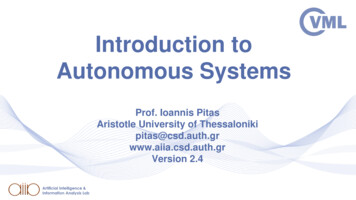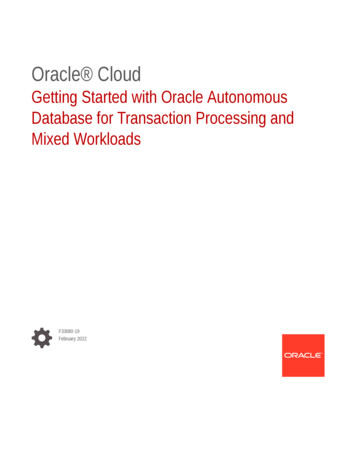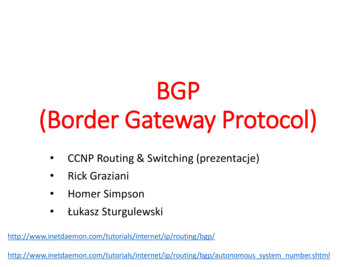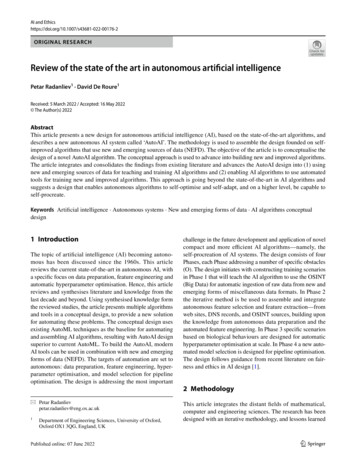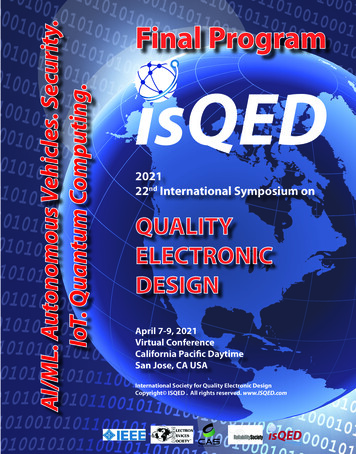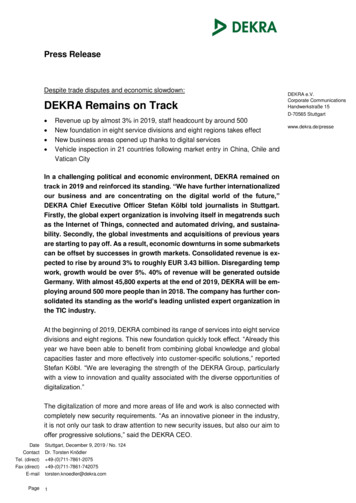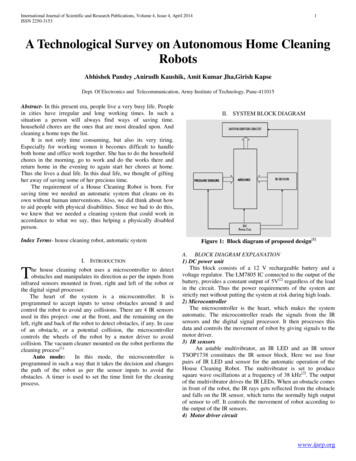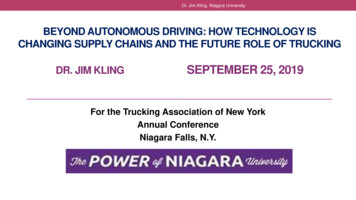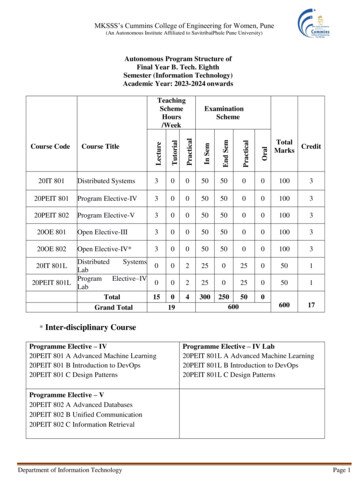
Transcription
MKSSS’s Cummins College of Engineering for Women, Pune(An Autonomous Institute Affiliated to SavitribaiPhule Pune University)Autonomous Program Structure ofFinal Year B. Tech. EighthSemester (Information Technology)Academic Year: 2023-2024 ticalIn SemEnd SemPracticalOralExaminationScheme20IT 801Distributed Systems300505000100320PEIT 801Program Elective-IV300505000100320PEIT 802Program Elective-V300505000100320OE 801Open Elective-III300505000100320OE 802Open 430025050600060017Course CodeCourse TitleDistributedSystems0LabProgram Elective–IV20PEIT 801L0LabTotal15Grand Total20IT 801LTotalCreditMarks* Inter-disciplinary CourseProgramme Elective – IV20PEIT 801 A Advanced Machine Learning20PEIT 801 B Introduction to DevOps20PEIT 801 C Design PatternsProgramme Elective – IV Lab20PEIT 801L A Advanced Machine Learning20PEIT 801L B Introduction to DevOps20PEIT 801L C Design PatternsProgramme Elective – V20PEIT 802 A Advanced Databases20PEIT 802 B Unified Communication20PEIT 802 C Information RetrievalDepartment of Information TechnologyPage 1
MKSSS’s Cummins College of Engineering for Women, Pune(An Autonomous Institute Affiliated to SavitribaiPhule Pune University)20OE801 Open 01H20OE801I20OE801J1120OE801KCourse TitleBig Data and AnalyticsCyber Physical SystemsDigital ControlIndustrial Engineering andManagementIntroduction to Cyber-crime andForensicsInstrumentation in Food andAgricultureMedical IoTQuantum ComputingRenewable Energy SourcesSoft ComputingSoftware Testing and QualityAssurance20OE802 Open Elective-IVSr. CourseNo. ble YYYYYYYYYYYYYYYYYYYYYYNNYYYYYYYYYYYYEligible DepartmentsCourse TitleEnTC CompApplied statistics with RYNProgrammingAutomobile EngineeringYYAutonomous RobotsNYBuilding Automation andYYEnergy AuditData Analysis andYNVisualizationData Science using PythonYNIndustrial Drives andYYControlSelection and Specificationof Material for EngineeringYYApplicationSmart Sensors andYYStructuresWireless NetworksNYDepartment of Information NYPage 2
MKSSS’s Cummins College of Engineering for Women, Pune(An Autonomous Institute Affiliated to SavitribaiPhule Pune University)20IT 801 Distributed SystemsTeaching Scheme:Lectures : 3 hours/weekTutorial : --Examination Scheme:In-Semester : 50 MarksEnd-Semester : 50 MarksCredit : 3Prerequisites:Web Technology, Computer Networks, Operating Systems, DatabaseManagement SystemsCourse Objectives:Familiarize students with1. Fundamental knowledge of distributed systems architectures and models.2. Process Communication and synchronization in a distributed environment.3. Methods of fault tolerance and replication for distributed systems4. Distributed File Systems and naming servicesCourse Outcomes:Students should be able to1. Apply basic concepts of Distributed systems for communication2. Apply various synchronization and mutual exclusion algorithms3. Recommend appropriate techniques for fault tolerance, resource and process management4. Explain concepts of Distributed File System and naming services for distributedenvironmentUnit – IIntroduction to Distributed Systems7 HoursCharacterization of Distributed Systems: Issues, Goals, and Types of distributed systems,Distributed System Models, Hardware concepts, Software concepts, Middleware: Models ofMiddleware, Services offered by middleware, Client Server model.Case Study: The World Wide WebUnit – IICommunication7 HoursLayered Protocols, Inter process communication (IPC): MPI, Remote Procedure Call (RPC),Remote Object Invocation, Remote Method Invocation (RMI), Message OrientedCommunication, Stream Oriented Communication, Group Communication.Unit – IIISynchronization7 HoursClock Synchronization, Logical Clocks, Election Algorithms, Mutual Exclusion, DistributedMutual Exclusion - Classification of mutual Exclusion Algorithm, Requirements of MutualExclusion Algorithms, and Performance measure.Election Algorithms- Non token based algorithm, Token based algorithm.Case Study: IBM’s Websphere Message-Queuing SystemDepartment of Information TechnologyPage 3
MKSSS’s Cummins College of Engineering for Women, Pune(An Autonomous Institute Affiliated to SavitribaiPhule Pune University)Unit – IVResource and Process Management7 HoursDesirable Features of global Scheduling algorithm, Task assignment approach, Load balancingapproach, load sharing approach, Introduction to process management, process migration,Threads, Virtualization, Clients, Servers, Code Migration.Unit – VReplication and Fault Tolerance7 HoursIntroduction to replication and consistency, Data-Centric and Client- Centric ConsistencyModels, Replica Management, Fault Tolerance: Introduction, Process resilience, Reliableclient-server and group communication, Recovery, Distributed Commit, checkpointsCase Study: Catching and Replication in WebUnit – VIDistributed File Systems and Name Services7 HoursIntroduction and features of DFS, File models, File Accessing models, File-Caching Schemes,File Replication, Case Study: Distributed File Systems (DSF), Network File System (NFS),Introduction to Name services and Domain Name System, Directory Services, Case Study: TheGlobal Name Service, The X.500 Directory ServiceDesigning Distributed Systems: Google Case StudyText Books1. Andrew S. Tanenbaum and Maarten Van Steen, “Distributed Systems: Principles andParadigms”, 2nd edition, Pearson Education.2. George Coulouris, Jean Dollimore, Tim Kindberg, “Distributed Systems: Concepts andDesign”, 4th Edition, Pearson Education, 2005.Reference Books1. S. Tanenbaum and M. V. Steen, “Distributed Systems: Principles and Paradigms”,Second Edition, Prentice Hall, 2006.2. M. L. Liu, “Distributed Computing Principles and Applications”, Pearson AddisonWesley, 2004.3. Sunita Mahajan, Seema Shah, “Distributed Computing”, Oxford University Press, 2ndEdition, ISBN-13: 978-0198093480.4. Abhijit Belapurkar, Anirban Chakrabarti, Harigopal Ponnapalli, Niranjan Varadarajan,Srinivas Padmanabhuni, Srikanth Sunder rajan, “Distributed System Security: Issues,Processes and solutions”, Willey online Library, ISBN: 978-0-470-51988-2.5. “Linux System Programming”, 2nd Edition, Robert Love, O’reillyDepartment of Information TechnologyPage 4
MKSSS’s Cummins College of Engineering for Women, Pune(An Autonomous Institute Affiliated to SavitribaiPhule Pune University)20PEIT 801A Advanced Machine LearningTeaching Scheme:Lectures : 3 hours/weekTutorial : --Examination Scheme:In-Semester : 50 MarksEnd-Semester : 50 MarksCredit : 3Prerequisites: Machine LearningCourse Objectives:Familiarize students with1. Selection of appropriate features of the dataset for processing2. Various algorithms in Ensemble Learning3. Fundamentals of Reinforcement Learning4. Basic concepts of Neural Network and Deep LearningCourse Outcomes:Students should be able to1. Perform preprocessing tasks such as dimensionality reduction, vectorization of an imageand so on2. Explain wide variety of advanced Machine Learning algorithms and techniques3. Apply advanced Machine Learning techniques to solve real-world problems4. Compare various advanced Machine Learning algorithmsUnit – IDimensionality Reduction7 HoursIntroduction to Dimensionality Reduction, Feature Selection, Subset Selection, PrincipalComponent Analysis, Linear Discriminant AnalysisUnit – IIEnsemble and Reinforcement Learning9 HoursEnsemble Learning: Wisdom of crowd, Bagging – Bootstrap, Random Forest, Boosting –AdaBoostReinforcement Learning: Concept, elements of RL, K-armed Bandit problem, Q-learningIncremental Learning: Concept, an adaptive incremental learning frameworkUnit – IIINeural Network and Artificial Neural Network9 HoursBiological motivation, neurons, McCulloch Pitts neurons, logic gates, Limitations ofMcCulloch Pitts neurons, Perceptron, Limitations of perceptron, Single Layer Perceptron,Activation layers, Artificial Neural Network and XOR and Multi-layer Perceptron, Error inoutput, Backpropagation, Gradient DescentUnit – IVConvolutional Neural Network9 HoursVectorization of an image, concept of Convolutional Neural Network, Properties ofConvolutional Neural Network, Convolutions, Filters, Strides, layers, padding, Channels,Pooling, Flattening, fully connected network, Convolutional Neural Network and imageDepartment of Information TechnologyPage 5
MKSSS’s Cummins College of Engineering for Women, Pune(An Autonomous Institute Affiliated to SavitribaiPhule Pune University)datasets.Unit – VSequence Modeling: Recurrent Neural Network8 HoursUnfolding Computational Graphs, Recurrent Neural Network, Bi-directional Recurrent NeuralNetwork, Encoder-Decoder Sequence to Sequence Architecture, The challenge of Long-TermDependencies, Long Short-Term Memory.Text Books1. Etham Alpaydin, “Introduction to Machine Learning”, PHI 2nd Edition – 2013.2. Ian Goodfellow, Yoshua Bengio, Aaron Courville, “Deep Learning”, MIT Press – 2016.Reference Books1. Nikhil Buduma, “Fundamentals of Deep Learning – Designing Next Generation MachineIntelligence Algorithms”, O’Reily – 1st Edition – 2017.2. Parag Kulkarni, “Reinforcement Learning and Systemic Machine Learning for DecisionMaking”, IEEE Press – 2015.3. Haibo He, “Self-Adaptive Systems for Machine Intelligence”, Wiley – 2011.Other Resources1. MNIST datasets: https://www.kaggle.com/datasets?search mnist2. CIFAR datasets: https://www.kaggle.com/datasets?search cifarDepartment of Information TechnologyPage 6
MKSSS’s Cummins College of Engineering for Women, Pune(An Autonomous Institute Affiliated to SavitribaiPhule Pune University)20PEIT 801B Introduction to DevOpsTeaching Scheme:Lectures : 3 hours/weekTutorial : --Examination Scheme:In-Semester : 50 MarksEnd-Semester : 50 MarksCredit : 3Prerequisites: Operating Systems and Cloud ComputingCourse Objectives:Familiarize students with1. DevOps Continuous Development and Continuous Integration.2. DevOps Operation Services.3. DevOps Architecture.4. DevOps Technologies.Course Outcomes:Students should be able to1. Explain DevOps framework and security aspects in DevOps2. Apply advanced strategies for software deployment3. Employ appropriate type of testing in DevOps environment4. Analyze data to detect anomaliesUnit – IIntroduction to DevOps7 HoursIntroduction, Why DevOps?, DevOps Perspective, DevOps and Agile, Team Structure,Co- ordination and barriers. The cloud as a platform, Operations, Operations Services, ServiceOperation Functions, Continual Service Improvement, Operation and DevOps.Unit – IIDeployment Pipeline6 HoursOverall Architecture, Does DevOps require architectural change? Overall architecture structure,Microservice architecture, Amazon’s rules for teams, Microservice adoption for existing systems.Unit – IIIBuilding and Testing7 HoursMoving a system through the deployment pipeline, Crosscutting aspects, Development and preCommit testing, UAT/Staging/Performance Testing, Production, Incidents, Deployment –Strategies for managing a deployment, logical consistency, packaging, deploying to multipleEnvironments, partial deployment, rollback, toolsUnit – IVDeployment7 HoursIntroduction, Strategies for Managing a Deployment, Logical Consistency, Packaging, Deployingto multiple environments, partial deployments, Rollback, Tools.Unit – VMonitoring7 HoursIntroduction, what to monitor, How to monitor, When to change the monitoringconfiguration, Interpreting monitoring data, challenges, tools, diagnosing an anomaly fromDepartment of Information TechnologyPage 7
MKSSS’s Cummins College of Engineering for Women, Pune(An Autonomous Institute Affiliated to SavitribaiPhule Pune University)monitoring data.Unit – VITrends in DevOps8 HoursGitOps, MLOps, AIOps, DataOps, DevSecOpsText Books1. Len Bass, Ingo Weber, Liming Zhu, DevOpsA software Architect’s Perspective,Pearson, First edition.2. Sanjeev Sharma, The DevOps Adoption Playbook, A guide to adopting DevOps in a MultiSpeed IT Enterprise. Wiley, IBM Press.Reference Books1. Jennifer Davis and Katherine Daniels, “Effective DevOps”, O’Reilly, First Edition2. Deepak Gaikwad, Viral Thakkar, “DevOps Tools from practitioner’s Viewpoint”, Wiley,First Edition3. Mark Treveil, Nicolas Omont, Clément Stenac, Kenji Lefevre, Du Phan, Joachim Zentici,Adrien Lavoillotte, Makoto Miyazaki, Lynn Heidmann, “Introducing MLOps”, O’ReillyNov 20204. Billy Yuen, Jesse Suen, Alex Matyushentsev, Todd Ekenstam, “GitOps and Kubernetes”,O’Reilly, April 20215. John Schnidt and Kirit Basu, “DataOps: The Authoritative Edition”, Sept 20196. Geradus Blokdyk, “DevSecOps: A Complete Guide”, 2019 EditionDepartment of Information TechnologyPage 8
MKSSS’s Cummins College of Engineering for Women, Pune(An Autonomous Institute Affiliated to SavitribaiPhule Pune University)20PEIT 801C Design PatternsTeaching Scheme:Lectures : 3 hours/weekTutorial : --Examination Scheme:In-Semester : 50 MarksEnd-Semester : 50 MarksCredit : 3Prerequisites: Object Oriented Analysis and Design LaboratoryCourse Objectives:Familiarize students with1. Principles of software design2. Necessity of Design Patterns3. Different types of Design Patterns4. Applications of design patternsCourse Outcomes:Students should be able to1. Identify low cohesion and high coupling in a given problem statement2. Apply behavioral design Patterns to incorporate enhanced class collaboration3. Apply structural design patterns to overcome the structural incompatibility4. Analyze scenarios for application of creational design patternsUnit – IRole of Design Patterns in Software Design10 HoursSOLID principles, classification of design Patterns, applying SOLID principles using DesignPatternsUnit – IIBehavioral Design Patterns10 HoursStrategy as algorithmic loose cuping, State, Template method as skeleton of algorithm, Chainof responsibility as request handlers” chain , Observer as publish subscribeUnit – IIIStructural Design Patterns11 HoursAdapter as resolving interface incompatibilities, Proxy as placeholder, Façade simplificationin handling complex components, Composite compression of has a relationship to is arelationship, DecoratorUnit – IVCreational Design Patterns11 HoursSingleton as object instantiation restrictor, Factory method as interface for creating subclassobjects at run time, Abstract Factory as creating families of objects without specifying theirconcrete classesText Books1. Alan Shalloway and James Trott, “Design Patterns Explained: A new Perspective onobject oriented design”, Addison Wesley2. Kethy Seirra , “Head first Design Patterns”, SPD 2020Department of Information TechnologyPage 9
MKSSS’s Cummins College of Engineering for Women, Pune(An Autonomous Institute Affiliated to SavitribaiPhule Pune University)Reference Books1. Eric Gamma “Design Patterns: Elements of reusable object oriented software”Addison WesleyDepartment of Information TechnologyPage 10
MKSSS’s Cummins College of Engineering for Women, Pune(An Autonomous Institute Affiliated to SavitribaiPhule Pune University)20PEIT 802A Advanced DatabasesTeaching Scheme:Lectures : 3 hours/weekTutorial : --Examination Scheme:In-Semester : 50 MarksEnd-Semester : 50 MarksCredit : 3Prerequisites: Data structures, database management systems.Course Objectives:Familiarize students with1. Concepts and applications of advanced database architectures.2. Different ways to process queries in advanced databases.3. Storage and indexing structures.4. Security management in database management systems.Course Outcomes:Students should be able to1. Examine different database architecture of advanced databases.2. Analyze the techniques of transactions and query processing in advanced databases.3. Devise appropriate ways to store and index data.4. Apply appropriate database security techniques.Unit – IParallel Databases7 HoursDatabase system architecture, client server architecture, parallel database architecture, sharedmemory, shared disk, shared nothing, hierarchical, I/O parallelism, inter query parallelism, intraquery parallelism, interoperation parallelism, intra operation parallelism, design of parallelsystems.Unit – IIDistributed Databases7 HoursDistributed system architecture, homogenous and heterogeneous databases, distributed datastorage, distributed transaction, commit protocol, concurrency control in distrusted databases,availability, distributed query processing, cloud databases.Unit – IIITransaction processing in advance databases7 HoursDistributed transactions, commit protocols, concurrency control in distributed databases,replication, extended concurrency control protocols, coordinator selection, Consensus inDistributed SystemsUnit – IVBig Databases7 HoursIntroduction to Big Data, NoSQL database system – Column based and key value basedColumn based Database ( Cassandra ) : Architecture, Managing data, Data Caching, Tuning,Data backup, Cassandra Query Language, CQL Data Model, Indexing Key Value based Database(DynamoDB) : Data Model, Operations, Data Access, Indexing.Department of Information TechnologyPage 11
MKSSS’s Cummins College of Engineering for Women, Pune(An Autonomous Institute Affiliated to SavitribaiPhule Pune University)Unit – VDatabase Indexing and hashing7 HoursBasics of query processing, Introduction to indexing, ordered indices, B tree index files, B treeextensions, Hash indices, Multiple key access, creation of indices, write optimized indexstructure, bitmap indices, indexing of spatial and temporal data, static and dynamic hashing.Unit – VINo SQL and semi structured Data Management7 HoursIntroduction to Big Data, No SQL Databases, MongoDB, Map reduce. XML Databases, DTD,XML Schemas, XQuery, XPath. JSONText Books1. Silberschatz A., Korth H., Sudarshan S, Database System Concepts, McGraw HillPublication, ISBN- 0-07-120413-X, Sixth Edition.2. Ramez Elmasri, Shamkant B. Navathe, Fundamentals of Database Systems, PearsonPublication, ISBN-13: 978-0-136-08620-8Reference Books1. S. K. Singh, “Database Systems: Concepts, Design and Application”, PearsonPublication, ISBN-978-81- 317-6092-5.2. C J Date, “An introduction to Database Systems”, Addition-Wesley.3. Raghurama Krishnan, Johannes Gehrke, “Database Management Systems”, TATAMcGrawHill, 3rd Edition, 2003.4. Reema Thareja, “Data warehousing”, Oxford University Press. ISBN 0195699610.Department of Information TechnologyPage 12
MKSSS’s Cummins College of Engineering for Women, Pune(An Autonomous Institute Affiliated to SavitribaiPhule Pune University)20PEIT 802B Unified CommunicationsTeaching Scheme:Lectures : 3 hours/weekTutorial : --Examination Scheme:In-Semester : 50 MarksEnd-Semester : 50 MarksCredit : 3Prerequisites: Network Fundamentals, Computer NetworksCourse Objectives:Familiarize students with1. Compare Circuit switching and packet switching related to performance parameters.2. Choose VOIP protocols for unified communications.3. Analyze contact center as application of unified communications.4. Interpret emerging technologies/protocols in VOIP communications.Course Outcomes:Students should be able to1. Understand and apply VOIP unified communications and analytics concepts to ContactCenter Working.2. Design and Implement VOIP protocols for telecommunication systems/applications.3. Interpret and apply current or emerging knowledge in telecommunication engineering.4. Use relevant mathematics and computer science concepts as tools.Unit – IIntroduction to digital and lP Telephony7 HoursDigital Telephony: circuit switched networks, ss7, ISDN, Exchanges, E.164 Numbering Plans IPTelephony: Packet switched Networks, signaling & Media separation' Media Encapsulation 'RTP and RTCP, Audio and Video Codecs.Unit – IIVolP Protocols7 HoursH.323 Network Elements: Terminals, Gateway, Gatekeeper, Multi point Control UnitH.323 protocol: RAS Channel, H.225 Call signaling, H.245 Media signalingH.323 Call flows: Basic Audio and Video Call flowsSIP Network Elements: Registrar, Proxy, UAS, UAC, B2BUASIP Protocol: Requests and Responses, Methods, Headers and Parameters, Message structure,Transactions and Dialogs, Session Description Protocol SIP Call Flows: Basic Audio and VideoCall FlowsH.248 protocol : Media Gateways, Media Gateway controllers, commands, Transactions,Contexts, Terminations, Descriptors' PackagesUnit – IIIUnified Communications7 HoursLocal and Network features: Call Forward, Call coverage, Automatic Call Back, User Displays,Resource Optimization.Voice & Data Integration: IM, presence, voice mail,Collaboration: call Conferencing, Voice, Video, Data and content integration.Mobility: Mobile Clients, Session Border Controllers.Business Applications: Framework for custom applications, computer Telephony Interface,Application Sequencing.Department of Information TechnologyPage 13
MKSSS’s Cummins College of Engineering for Women, Pune(An Autonomous Institute Affiliated to SavitribaiPhule Pune University)Unit – IVInbound Contact Center7 HoursCall Centers: Introduction, Evolution and classification of Contact Centers.Inbound Contact Center :Introduction Self Service / Interactive Voice Response, Routing,Intelligent Routing, VXMLAgent : Skills, Selection Algorithms, Modes, Service Observing, RecordingUnit – VOutbound Contact Center and Reporting7 HoursOutbound contact center: Introduction, Proactive contact: voice, SMS, E-mail & chat. ContactCenter Reporting: Types of Reports, Business use cases. Analytics: Agent Performance,OccupancyUnit – VIEmerging technologies in Telecommunications7 HoursHigh Availability: Load balancing, Reliability, Failover & Failback, Location Redundancy,Hardware footprint, cloud Computing : Applications in Telecommunications Analytics in Voice& Data, Diagnostics & ManagementEmerging Technologies: Google Glass, WebRTC, Hosting on Cloud.Text Books1. Allan Sulkin, “PBX Systems for IP Telephony”, McGraw-Hill ProfessionalReference Books1.2.3.4.5.6.7.ITU-T H.323 Packet-based multimedia communications systemsITU-TH.225Call Signaling Protocols and media stream packetizationITU-T H-245 Control protocol for multimedia communicationIETF RFC 326131P: Session Initiation ProtocolIETF RFC4566 SDP: Session Description ProtocolContact Center for' Dummies, Wiley Publishing Inc.Real Time Communication with WebRTC, O’reilly PublishingDepartment of Information TechnologyPage 14
MKSSS’s Cummins College of Engineering for Women, Pune(An Autonomous Institute Affiliated to SavitribaiPhule Pune University)20PEIT 802C Information RetrievalTeaching Scheme:Lectures: 3 hrs/weekTutorial: --Examination Scheme:In-Semester:50 MarksEnd-Semester: 50 marksCredits:3Prerequisites: Data structuresCourse Objectives:Familiarize students with1. Concepts of Information Retrieval System.2. Indexing techniques of Information Retrieval System3. Clustering in Information Retrieval System4. Information sharing on semantic webCourse Outcomes:Students will be able to:1. Apply various algorithms for Information Retrieval System2. Analyze Search Strategies used in Information Retrieval System3. Apply different web mining concepts4. Explain modern trends in Information Retrieval SystemUnit – IIntroduction7 HoursBasic Concepts of Information Retrieval, IR system architecture. Automatic Text Analysis:Luhn’s ideas, Conflation Algorithm, Porter Stemmer, Retrieval Evaluation: Precision, Recall,F-Score, Mean Average Precision, Mean Reciprocal Rank, User oriented measuresUnit – IIFinite Automata with application7 HoursIndexing and Index Term Weighing, Probabilistic Indexing, Inverted file, Suffix trees & suffixarrays, Signature Files, Clustered files, Cluster Hypothesis, Clustering Algorithms: Single PassAlgorithm, Single Link Algorithm, Complete Link AlgorithmUnit – IIISearch Strategies7 HoursRetrieval strategies: Vector Space model, Probabilistic retrieval strategies, Language models,Inference networks, Extended Boolean retrieval, Latent semantic indexing, Fuzzy set retrievalUnit – IVWeb Mining7 HoursSearching the Web: Challenges, Characterizing the Web, Search Engines, Browsing, Matasearchers, Web crawlers, Meta-crawler, Web data mining, Finding needle in the Haystack,Searching using HyperlinksUnit – VSemantic Search Systems7 HoursSemantic Search systems, Semantic Web, Ontology, Searching across ontologies, semantic websearch, Google knowledge graphsDepartment of Information TechnologyPage 15
MKSSS’s Cummins College of Engineering for Women, Pune(An Autonomous Institute Affiliated to SavitribaiPhule Pune University)Unit – VITrends In Information RetrievalCase Study: Google Analytics, Search EngineRecommendation Systems: Collaborative FilteringOptimization,Ranking7 HoursAlgorithms,Text Books1. Yates & Neto, “Modern Information Retrieval”, Pearson Education, ISBN:81-297-0274-62. C.J. Rijsbergen, “Information Retrieval”, (www.dcs.gla.ac.uk).,2ndISBN:978- 408709293Reference Books1. Grigoris Antoniou and Frank van Harmelen, “A semantic Web Primer”, Massachusetts.2. Christopher D. Manning, Prabhakar Raghavan and Hinrich Schutzen, “Introduction toInformation Retrieval”, Cambridge University Press, Online book, ISBN:978-0-52186571-5.Department of Information TechnologyPage 16
MKSSS’s Cummins College of Engineering for Women, Pune(An Autonomous Institute Affiliated to SavitribaiPhule Pune University)20OE 801K Software Testing and Quality AssuranceTeaching Scheme:Lectures : 3 hours/weekTutorial : --Examination Scheme:In-Semester : 50 MarksEnd-Semester : 50 MarksCredit : 3Prerequisites:Course Objectives:Familiarize students with1. Testing strategies in projects.2. Levels of testing strategies3. Various quality assurance models4. Automated Testing ToolsCourse Outcomes:Students should be able to1. Explain different terminologies in software testing.2. Apply appropriate testing technique based on the project scenario3. Choose quality assurance models for the project4. Make use of modern testing tools suitable for the projectUnit – IFundamentals7 HoursTesting as a Process, Software testing principles, The tester’s role in a software developmentorganization, Origins of defects, Defect classes, Testing fundamentals, the defect repository andtest design, Defect examples, Developer /Tester support for developing a defect repository.Process model to represent Different phases, Lifecycle modelsUnit – IILevels of testing7 HoursNeed for levels of testing, Unit testing, Integration testing, System Testing - Usability andAccessibility Testing, Configuration Testing, Compatibility Testing, Stress testing, Regressiontesting, Alpha, Beta and Acceptance testing.Unit – IIITesting techniques7 HoursUsing White Box Approach to Test design - Static Testing, Structural Testing, Unit FunctionalTesting, Challenges in White box testing, Using Black Box Approaches to Test Case Design,Random Testing, Requirements based testing, Decision tables, State-based testing, Cause-effectgraphing, Error guessing, Compatibility testing.Unit – IVFundamentals of software quality assurance7 HoursSQA basics, Components of the Software Quality Assurance System, software quality inbusiness context, planning for software quality assurance, product quality and process quality,software process models, 7 QC Tools and Modern Tools.Unit – VQuality assurance models7 HoursModels for Quality Assurance, ISO-9000 series, CMM, CMMI, Test Maturity Models, SPICE,Department of Information TechnologyPage 17
MKSSS’s Cummins College of Engineering for Women, Pune(An Autonomous Institute Affiliated to SavitribaiPhule Pune University)Malcolm Baldrige Model- P-CMM, Clean-room software engineering, Defect Injection andprevention, Inspections & Walkthroughs, Case Tools and their effect on Software Quality.Unit – VISoftware test automation7 HoursSoftware Test Automation, Skills needed for Automation, Scope of Automation, Design andArchitecture for Automation, Requirements for a Test Tool, Challenges in Automation Trackingthe Bug. Combining Manual and Automated TestingText Books1. Srinivasan Desikan, Gopalaswamy Ramesh, “Software Testing: Principles andPractices”, Pearson2. Ilene Burnstein, “Practical Software Testing”, Springer International editionReference Books1. Paul C. Jorgensen, “Software Testing: A Craftsman’s Approach”, Auerbach Publications2. William Perry, “Effective Methods of Software Testing”, Wiley Publishing, Third Edition3. Stephen Kan, “Metrics and Models in Software Quality”, Addison – Wesley, SecondEdition4. Watts S Humphrey, “Managing the Software Process”, Pearson Education Inc.Department of Information TechnologyPage 18
MKSSS’s Cummins College of Engineering for Women, Pune(An Autonomous Institute Affiliated to SavitribaiPhule Pune University)20OE 802A Applied Statistics with R programmingTeaching Scheme:Lectures : 3 hours/weekTutorial : --Examination Scheme:In-Semester : 50 MarksEnd-Semester : 50 MarksCredit : 3Prerequisites: MathematicsCourse Objectives:Familiarize students with1. Fundamentals in Statistics2. Evaluation and Interpretation of applied statistics3. Hypothesis Test4. R programming used in statistical analysisCourse Outcomes:Students should be able to1. Apply probability for statistical analysis.2. Draw inferences from statistical analysis of data3. Apply statistical methods and hypothesis tests on data4. Explain Multivariate AnalysisUnit – IProbability7 HoursIntroduction, conditional probability, Bayes Theorem and independence, random variable andProbability distribution, normal distribution.Unit – IIBasic statistical measures9 HoursIntroduction to statistics, type of data, processing the data, classification, graphicalrepresentation.Introduction Measures of central Tendency: Arithmetic Mean, Weighted Arithmetic Mean,Median, mode, Measurement of variation: Quartile, Average and Standard Deviations,Coefficient Variation, Measurement of skewnessCase St
Jan 14, 2022 · 1. Apply basic concepts of Distributed systems for communication 2. Apply various synchronization and mutual exclusion algorithms 3. Recommend appropriate techniques for fault tolerance, resource and process management 4. Explain concepts of Distributed Fi

